Study on Bearing Capacity and Failure Mode of Multi-Layer-Encased Geosynthetic-Encased Stone Column under Dynamic and Static Loading
Abstract
1. Introduction
2. Model Test Design
2.1. General Situation of Test
2.2. The Test Equipment and Instruments
2.3. Test Material
2.4. Test Filling and Loading Mode
3. Experimental Results
3.1. Compression Test of Single GESC under Dynamic Loading
3.1.1. Influence of Cycle Number on Bearing Capacity
3.1.2. Influence of Encasement Layer on Bearing Capacity
3.2. Compression Test of Single GESC under Static Loading
3.3. Comparative Analysis of Load-Bearing Performance under Dynamic and Static Loading
3.3.1. Analysis of Stone Column Settlement
3.3.2. Analysis of Stone Column Failure Mode
3.3.3. Analysis of Lateral Earth Pressure around Stone Column
3.4. Analysis of GESC Bearing Mechanism under Dynamic and Static Loading
4. Conclusions
- The multi-layer encasement improved the vertical stiffness of the stone column, and the overlapping part of the external geogrid could fix the aggregate protruding due to the destruction of the internal geogrid, which improved the bearing capacity and delayed the failure of the stone column. Therefore, compared with stone column encased by a one-layer geogrid, a multi-layer geogrid-encased stone column has significantly improved bearing performance; in addition, a three-layer geogrid-encased stone column compared with a two-layer geogrid-encased stone column, under dynamic and static loading, had a vertical ultimate bearing capacity increased by 56.5% and 9.4%, respectively; the difference in the degree of improvement was obvious. Therefore, the encasement method should be reasonably selected according to the load type for the soft foundation treatment project. When a GESC is applied to the soft foundation treatment under static loading, two layers of encasement is the optimal number of layers for the stone column based on engineering feasibility and economy, while three layers of encasement are the optimal number of layers for the stone column when dynamic loading is considered;
- Under dynamic and static loading, the stone columns all undergo the compression-density stage—linear elastic stage—yielding stage—failure stage; the GESC failure mode is bulging failure, and the main radial strains appear at the same height, so the effect of the difference between dynamic and static loading can be ignored. However, compared with static loading, the lateral restraint effect on the stone column is weaker under dynamic loading, and the radial strain is more uniform and smaller along the column height;
- Compared with static loading, the vibration effect of dynamic loading disturbs the soil around the column and weakens the lateral restraint effect on the column, which indirectly leads to a decrease in the modulus of the GESC and a decreased stress transfer rate. Meanwhile, with the increase in encasement layers, the overlapping of multi-layer geogrid increased the vertical modulus and lateral restraint, which increased the stress transfer rate and reduced the difference between dynamic and static loading on column failure;
- Under the same conditions, the dynamic loading was relative to the static loading, and the vertical ultimate bearing capacity of the column encased by one-layer and two-layer geogrid under the dynamic loading was 5.0~20.3% lower than the static loading. When designing and serving soft foundation treatment projects such as expressways and high-speed railways, it is necessary to consider the impact of traffic loads on the bearing capacity of the stone column, and appropriately increase the design value of the bearing capacity of the stone column.
Author Contributions
Funding
Institutional Review Board Statement
Informed Consent Statement
Data Availability Statement
Conflicts of Interest
References
- Impe, W.V.; Silence, P. Improving of the bearing capacity of weak hydraulic fills by means of geotextiles. In International Conference on Geotextiles; OIAV, Wien: Vienna, Austria, 1986; pp. 1411–1416. [Google Scholar]
- Malarvizhi, S.N. Comparative study on the behavior of encased stone column and conventional stone column. Soils Found. 2007, 47, 873–885. [Google Scholar] [CrossRef]
- Murugesan, S.; Rajagopal, K. Geosynthetic-encased stone column: Numerical evaluation. Geotext. Geomembr. 2006, 24, 349–358. [Google Scholar] [CrossRef]
- Murugesan, S.; Rajagopal, K. Model tests on geosynthetic-encased stone columns. Geosynth. Int. 2007, 14, 346–354. [Google Scholar] [CrossRef]
- Alkhorshid, N.R.; Araujo, G.L.S.; Palmeira, E.M.; Zornberg, J.G. Large-scale load capacity tests on a geosynthetic encased column. Geotext. Geomembr. 2019, 47, 632–641. [Google Scholar] [CrossRef]
- Gu, M.; Han, J.; Zhao, M. Three-dimensional DEM analysis of single geogrid-encased stone columns under unconfined compression, a parametric study. Acta Geotech. 2017, 12, 559–572. [Google Scholar] [CrossRef]
- Gu, M.; Zhao, M.; Zhang, L.; Han, J. Effects of geogrid encasement on lateral and vertical deformations of stone columns in model tests. Geosynth. Int. 2016, 23, 100–112. [Google Scholar] [CrossRef]
- Kadhim, S.T.; Parsons, R.L.; Han, J. Three-dimensional numerical analysis of individual geotextile-encased sand columns with surrounding loose sand. Geotext. Geomembr. 2018, 46, 836–847. [Google Scholar] [CrossRef]
- Wu, C.-S.; Hong, Y.-S. Laboratory Tests on Geosynthetic-Encapsulated Sand Columns. Geotext. Geomembr. 2009, 27, 107–120. [Google Scholar] [CrossRef]
- Yoo, C. Performance of geosynthetic-encased stone columns in embankment construction, numerical investigation. J. Geotech. Geoenviron. Eng. 2010, 136, 1148–1160. [Google Scholar] [CrossRef]
- Ghazavi, M.; Yamchi, A.; Afshar, J.N. Bearing Capacity of Horizontally Layered Geosynthetic Reinforced Stone Columns. Geotext. Geomembr. 2018, 46, 312–318. [Google Scholar] [CrossRef]
- Chen, J.F.; Li, L.Y.; Zhang, Z.; Zhang, X.; Xu, C. Centrifuge modeling of geosynthetic-encased stone column-supported embankment over soft clay. Geotext. Geomembr. 2021, 49, 210–221. [Google Scholar] [CrossRef]
- Chen, J.F.; Zhang, X.; Yoo, C.; Gu, Z.A. Effect of basal reinforcement on performance of floating geosynthetic encased stone column-supported embankment. Geotext. Geomembr. 2022, 50, 566–580. [Google Scholar] [CrossRef]
- Yoo, C.; Abbas, Q. Performance of geosynthetic-encased stone column-improved soft clay under vertical cyclic loading. Soils Found. 2019, 59, 1875–1890. [Google Scholar] [CrossRef]
- Yoo, C.; Lee, D. Performance of geogrid-encased stone columns in soft ground, full-scale load tests. Geosynth. Int. 2012, 19, 480–490. [Google Scholar] [CrossRef]
- Chen, J.F.; Li, L.Y.; Xue, J.F.; Feng, S.Z. Failure mechanism of geosynthetic-encased stone columns in soft soils under embankment. Geotext. Geomembr. 2015, 43, 424–431. [Google Scholar] [CrossRef]
- Fang, H.; Zheng, J.-J.; Liu, Y.; Hou, R.-Y.; Jia, Z.-R. Analytical Solutions of the Dynamic Response of a Dual-Beam Model for a Geosynthetic Reinforced Pile-Supported Embankment under Moving Load. Comput. Geotech. 2022, 142, 104563. [Google Scholar] [CrossRef]
- Pham, H.; Dias, D.; Dudchenko, A. 3D Modeling of Geosynthetic-Reinforced Pile-Supported Embankment under Cyclic Loading. Geosynth. Int. 2020, 27, 157–169. [Google Scholar] [CrossRef]
- Pham, H.V.; Dias, D. 3D numerical modeling of a piled embankment under cyclic loading. Int. J. Geomech. 2019, 19, 1–15. [Google Scholar] [CrossRef]
- Zhang, X.; Yoo, C.; Chen, J.F.; Gu, Z.A. Numerical modeling of floating geosynthetic-encased stone column-supported embankments with basal reinforcement. Geotext. Geomembr. 2022, 50, 720–736. [Google Scholar] [CrossRef]
- Zhou, Y.; Kong, G.; Wen, L.; Yang, Q. Evaluation of geosynthetic-encased column-supported embankments with emphasis on penetration of column toe. Comput. Geotech. 2021, 132, 104039. [Google Scholar] [CrossRef]
- Yoo, C.; Abbas, Q. Laboratory investigation of the behavior of a geosynthetic encased stone column in sand under cyclic loading. Geotext. Geomembr. 2020, 48, 431–442. [Google Scholar] [CrossRef]
- Ardakani, A.; Gholampoor, N.; Bayat, M.; Bayat, M. Evaluation of monotonic and cyclic behaviour of geotextile encased stone columns. Struct. Eng. Mech 2018, 65, 81–89. [Google Scholar]
- Zhang, L.; Xu, Z.; Zhao, H.; Zhou, S. A Three-Dimensional Discrete Element Modeling to Cyclic Response of Geosynthetic-Encased Stone Column. Int. J. Geosynth. Ground Eng. 2021, 7, 75. [Google Scholar] [CrossRef]
- Wang, X.; Wang, Y.; Liao, C.; Cui, J.; Shen, J.H.; Wang, X.Z.; Zhu, C.Q. Particle Breakage Mechanism and Particle Shape Evolution of Calcareous Sand under Impact Loading. Bull. Eng. Geol. Environ. 2022, 81, 372. [Google Scholar] [CrossRef]
- Gniel, J.; Bouazza, A. Construction of geogrid encased stone columns: A new proposal based on laboratory testing. Geotext. Geomembr. 2010, 28, 108–118. [Google Scholar] [CrossRef]
- Law, K.; Wang, B. The use of large grained stone columns to strengthen very soft clays. In Landslides: Evaluation and Stabilization; A. A. Balkema: Leiden, The Netherlands, 2004; pp. 1701–1706. [Google Scholar]
- Shahu, J.T.; Reddy, Y.R. Clayey soil reinforced with stone column group: Model tests and analyses. J. Geotech. Geoenviron. Eng. 2011, 137, 1265–1274. [Google Scholar] [CrossRef]
- Baker, W.E.; Westine, P.S.; Dodge, F.T. Similarity Methods in Engineering Dynamics-Theory and Practice of Scale Modeling; Elsevier Science Publishers B.V.: Amsterdam, The Netherlands, 1991. [Google Scholar]
- Aqoub, K.; Mohamed, M.; Sheehan, T. Quantitative analysis of shallow unreinforced and reinforced piled embankments with different heights subject to cyclic loads: Experimental study. Soil Dyn. Earthq. Eng. 2020, 138, 106277. [Google Scholar] [CrossRef]
- Tang, Y.; Xiao, S.; Yang, Q. The behaviour of geosynthetic-reinforced pile foundation under long-term dynamic loads: Model tests. Acta Geotech. 2020, 15, 2205–2225. [Google Scholar] [CrossRef]
- JGJ 106-2014; Technical Code for Testing of Building Foundation Piles. China Academy of Building Research; China Architecture and Building Press: Beijing, China, 2014. (In Chinese)
- Hong, Y.S.; Wu, C.S.; Yu, Y.S. Model tests on geotextile-encased granular columns under 1-g and undrained conditions. Geotext. Geomembr. 2016, 44, 13–27. [Google Scholar] [CrossRef]
- Hugher, J.M.O.; Withers, N.J. Reinforcing of soft cohesive soils with stone columns. Ground Eng. 1974, 7, 42–49. [Google Scholar]
- Zhang, L.; Xu, Z.; Zhou, S. Vertical cyclic loading response of geosynthetic-encased stone column in soft clay. Geotext. Geomembr. 2020, 48, 897–911. [Google Scholar] [CrossRef]
- Chen, J.F.; Li, L.; Xu, C.; Feng, S.Z. Centrifugal model tests on composite foundation reinforced by geosynthetic-encased stone columns under embankment loads. Chin. J. Geotech. Eng. 2017, 40, 932–938. [Google Scholar]
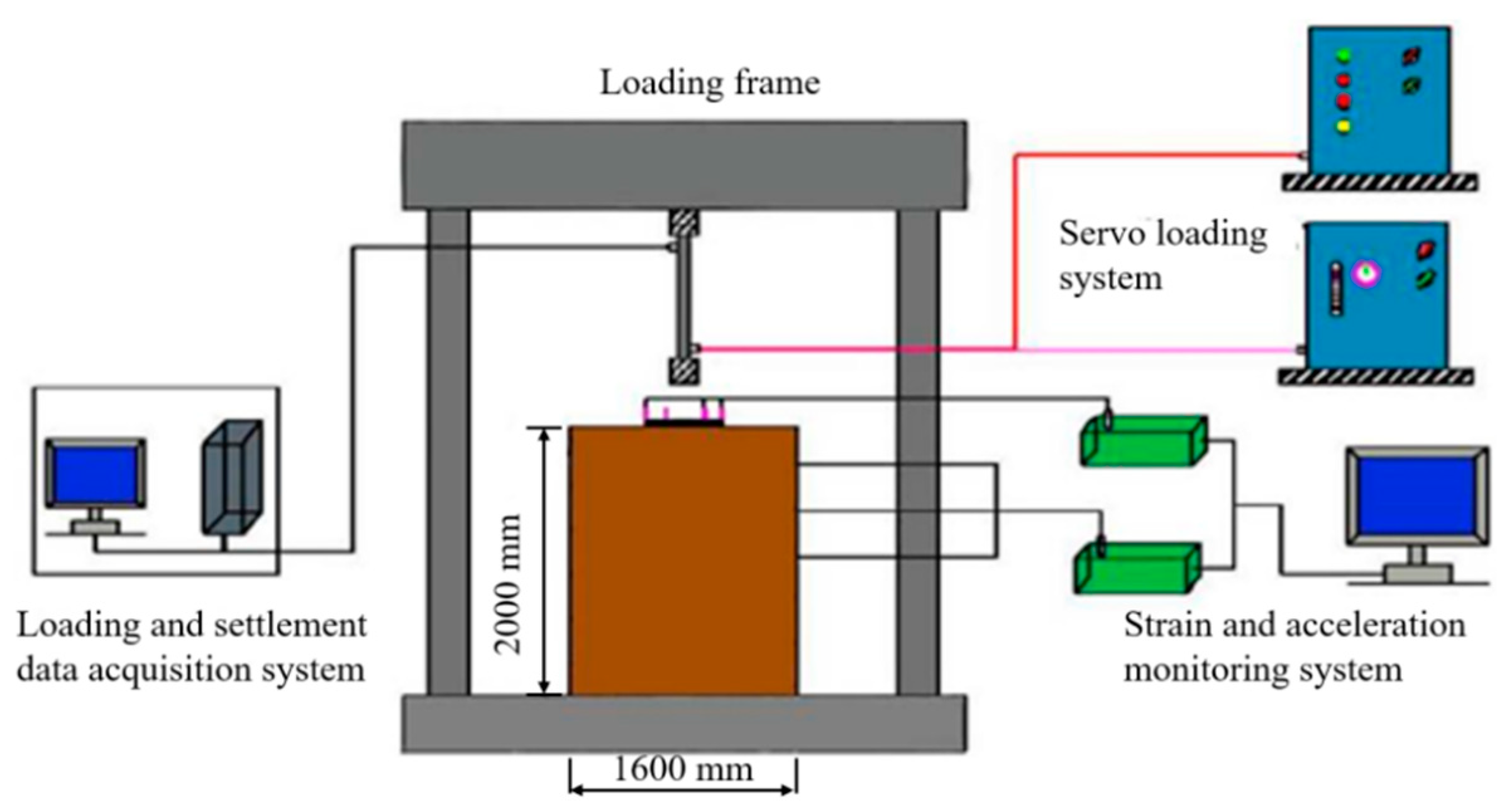
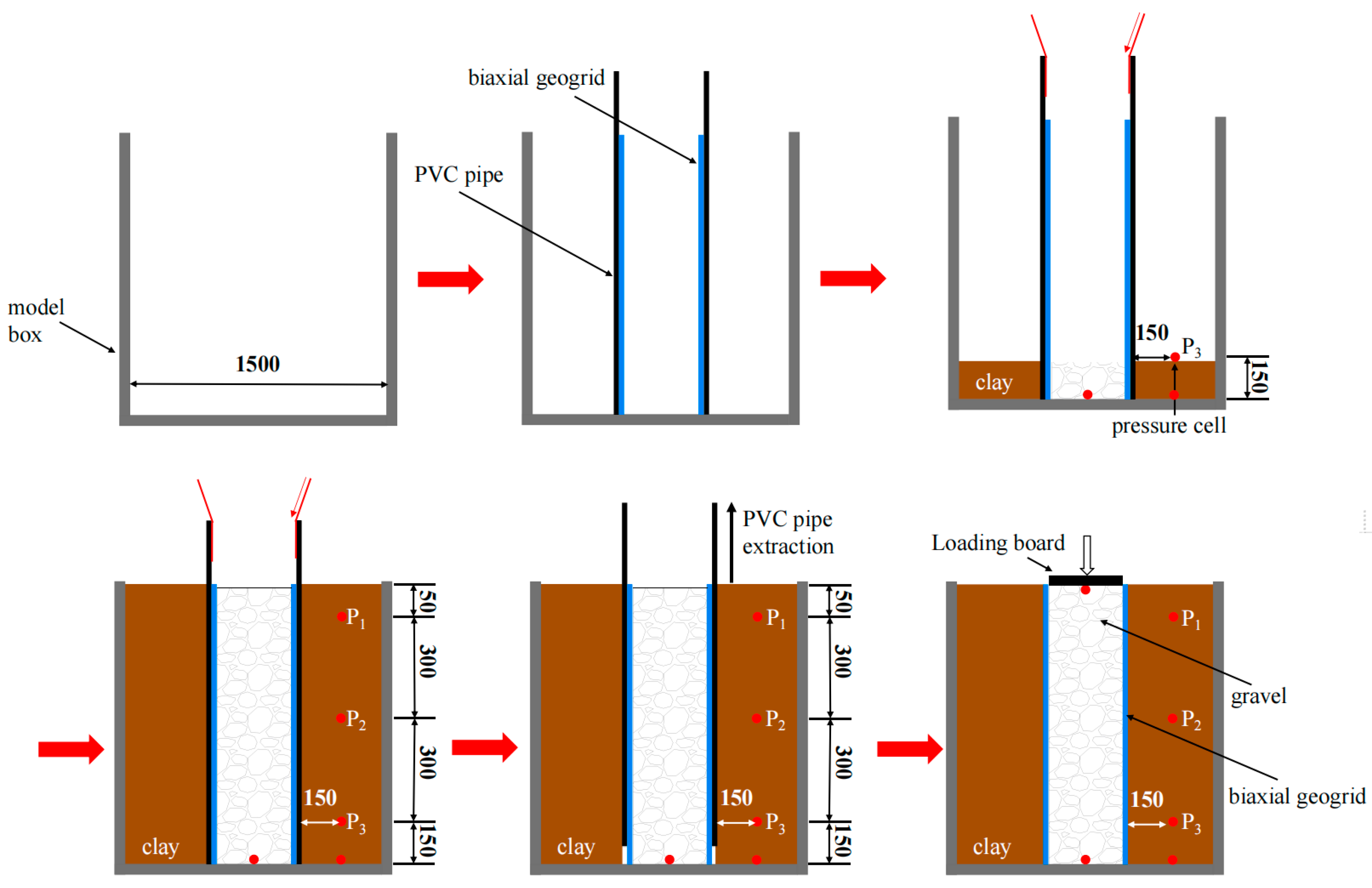
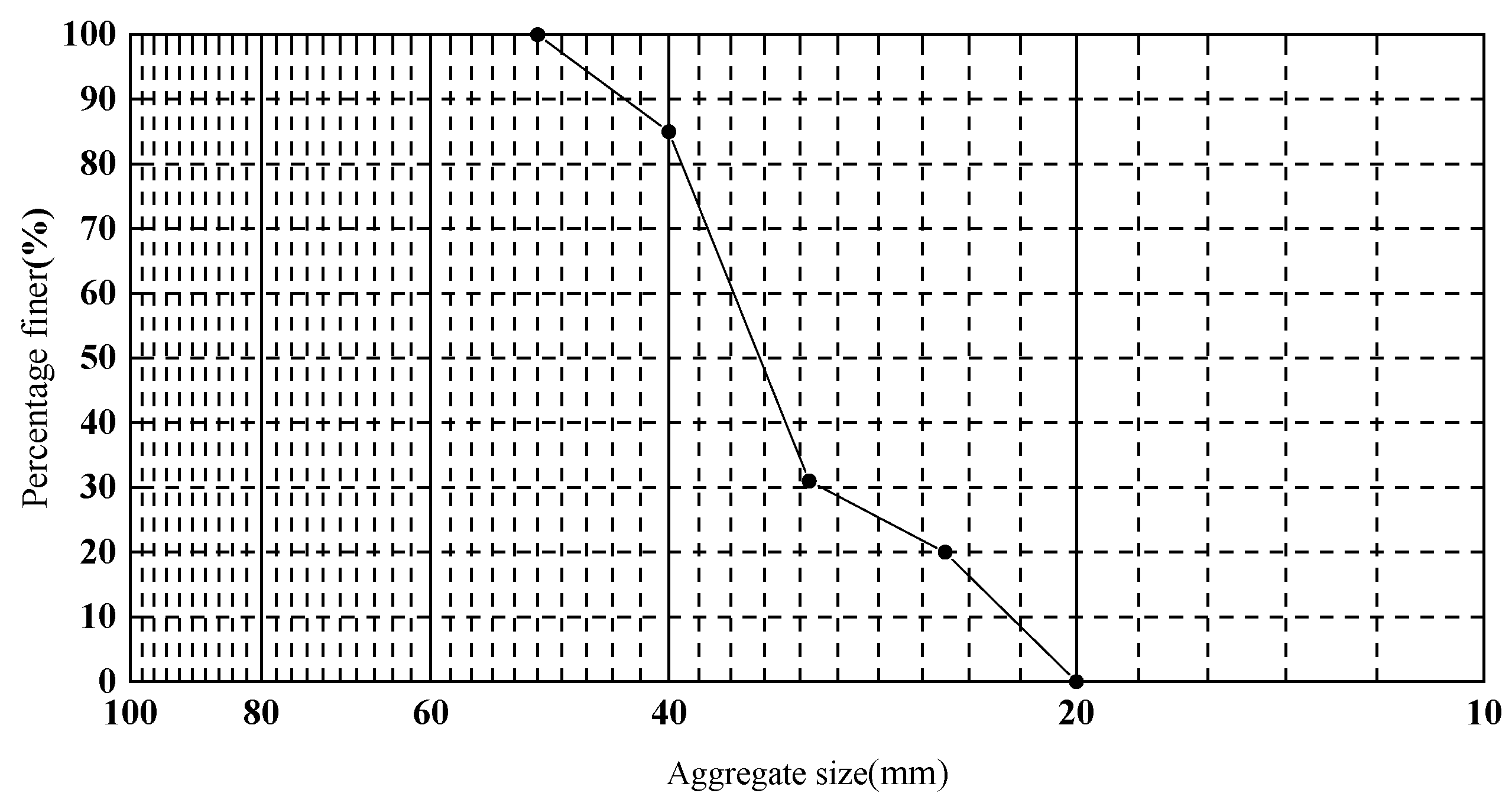


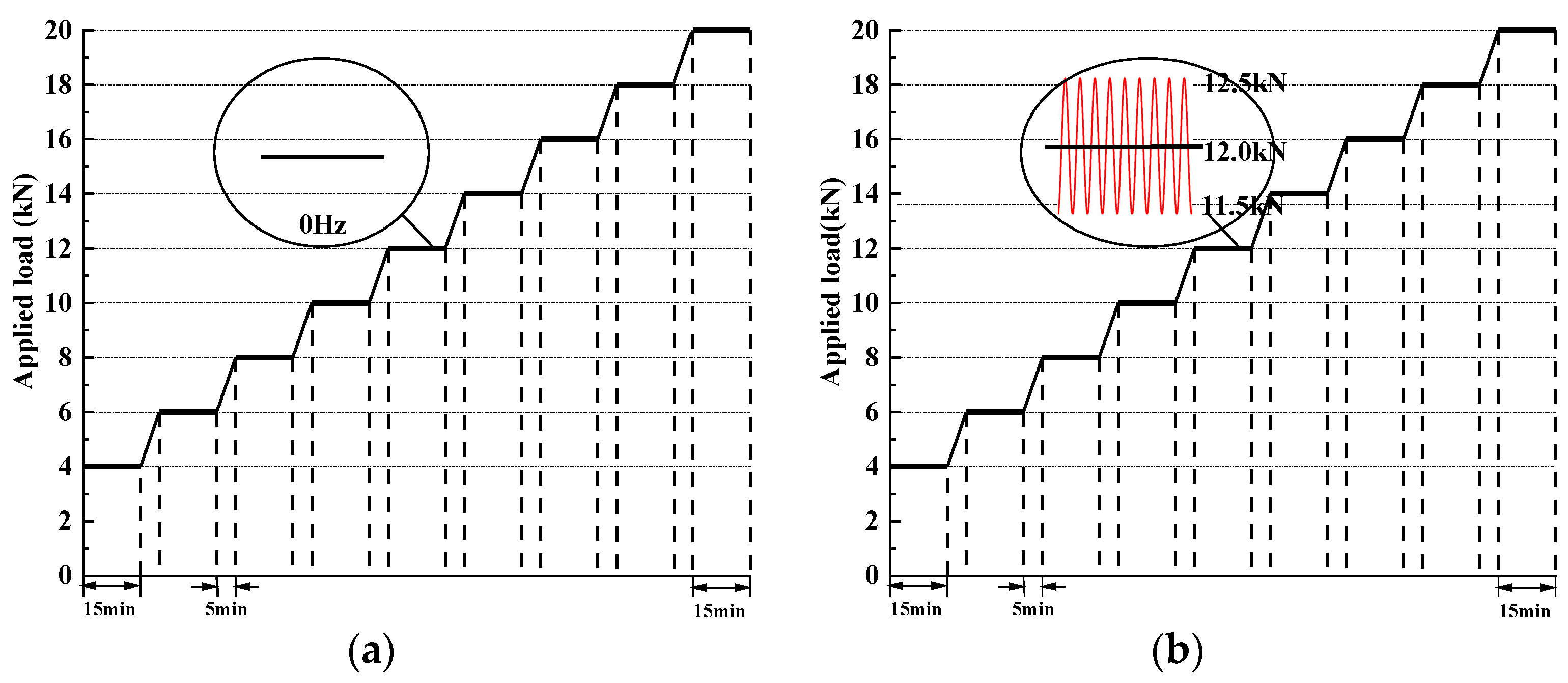
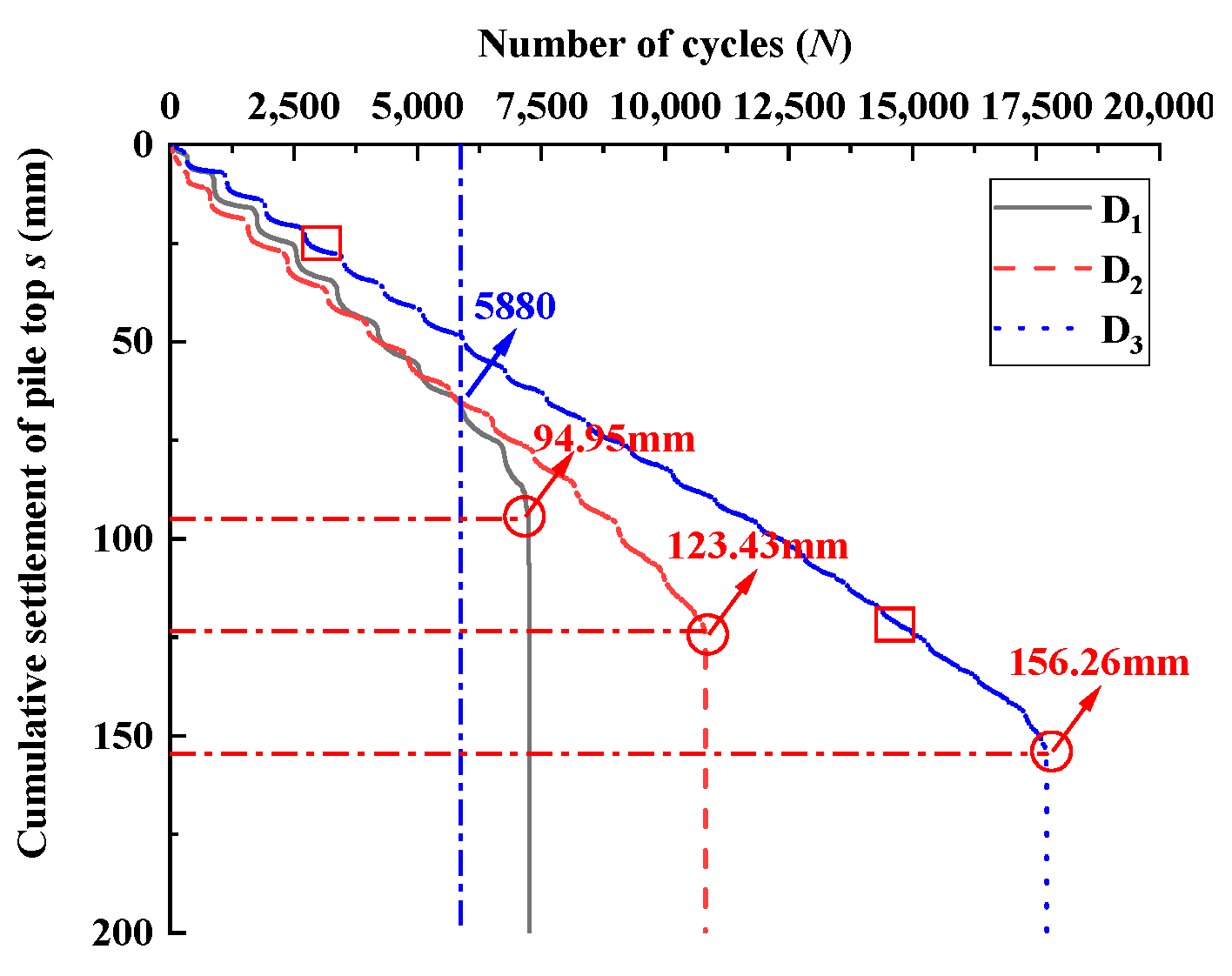
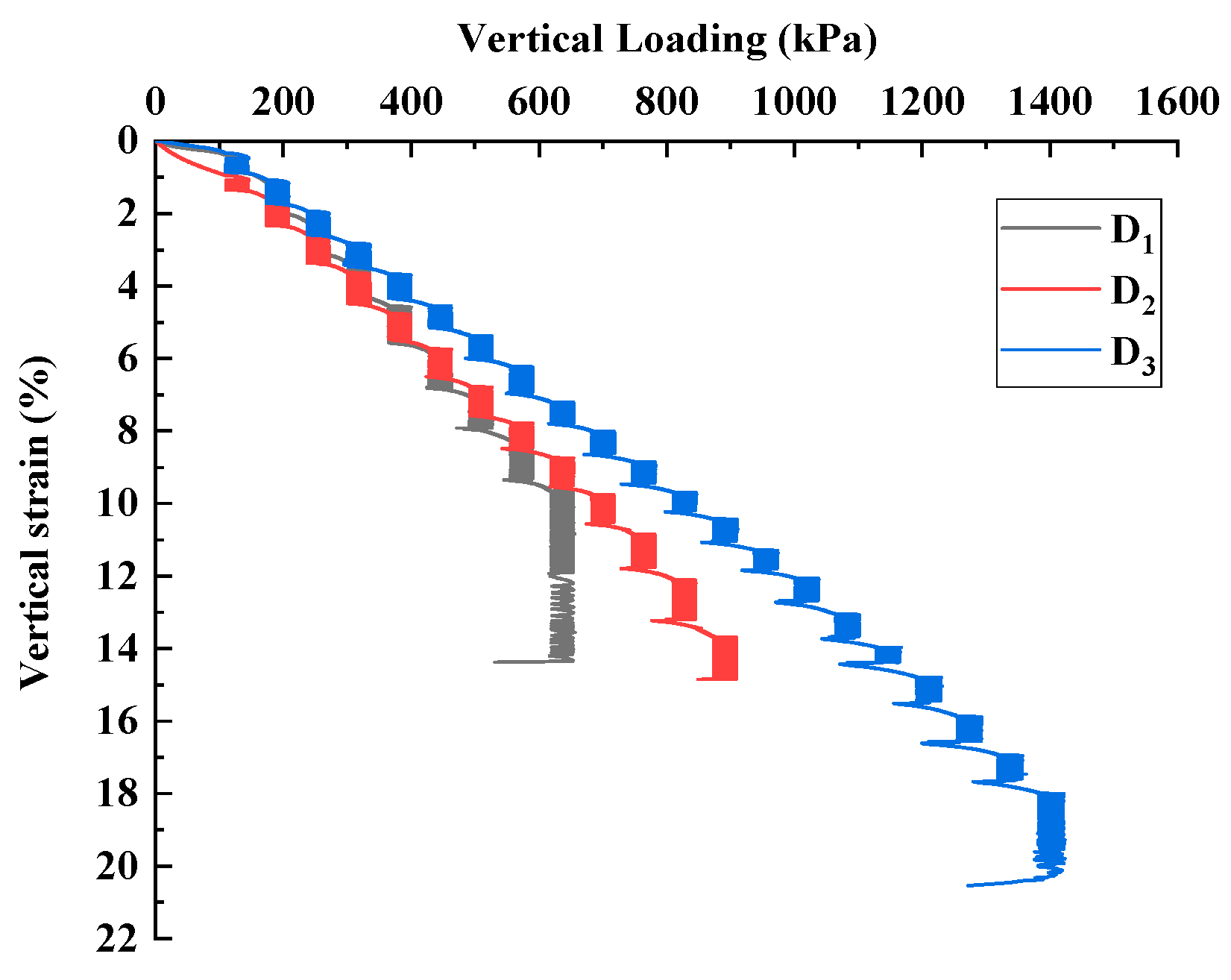


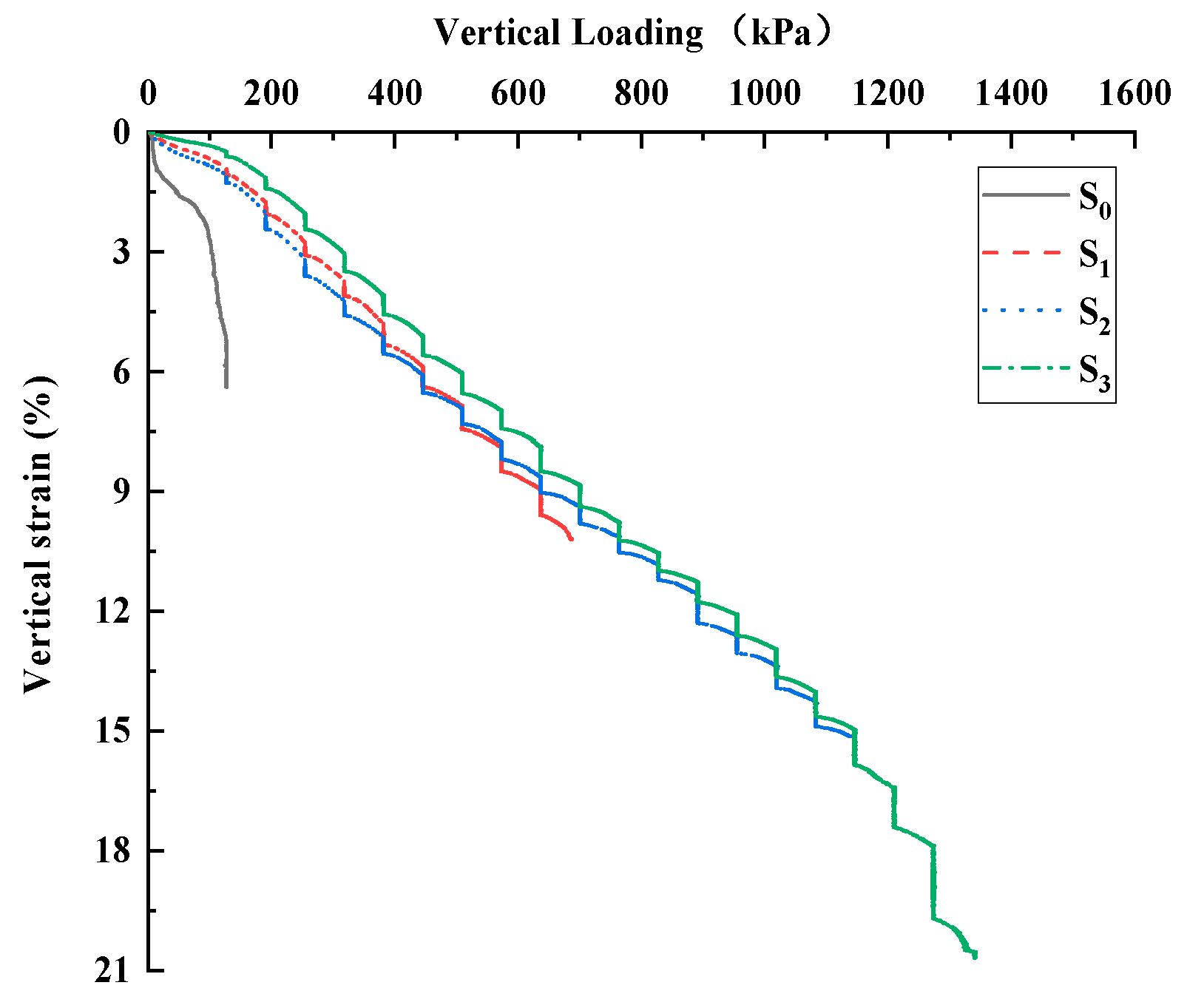
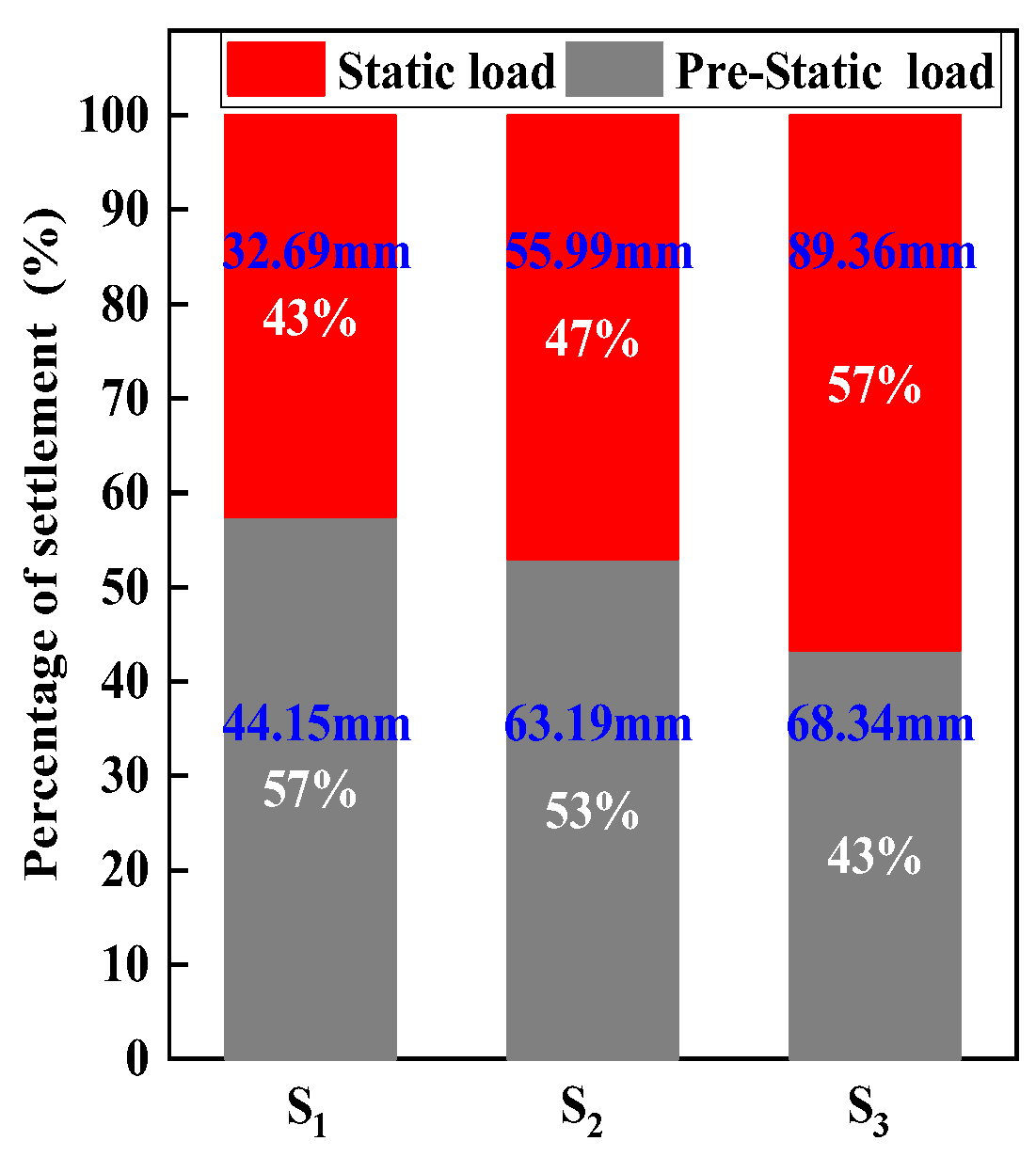
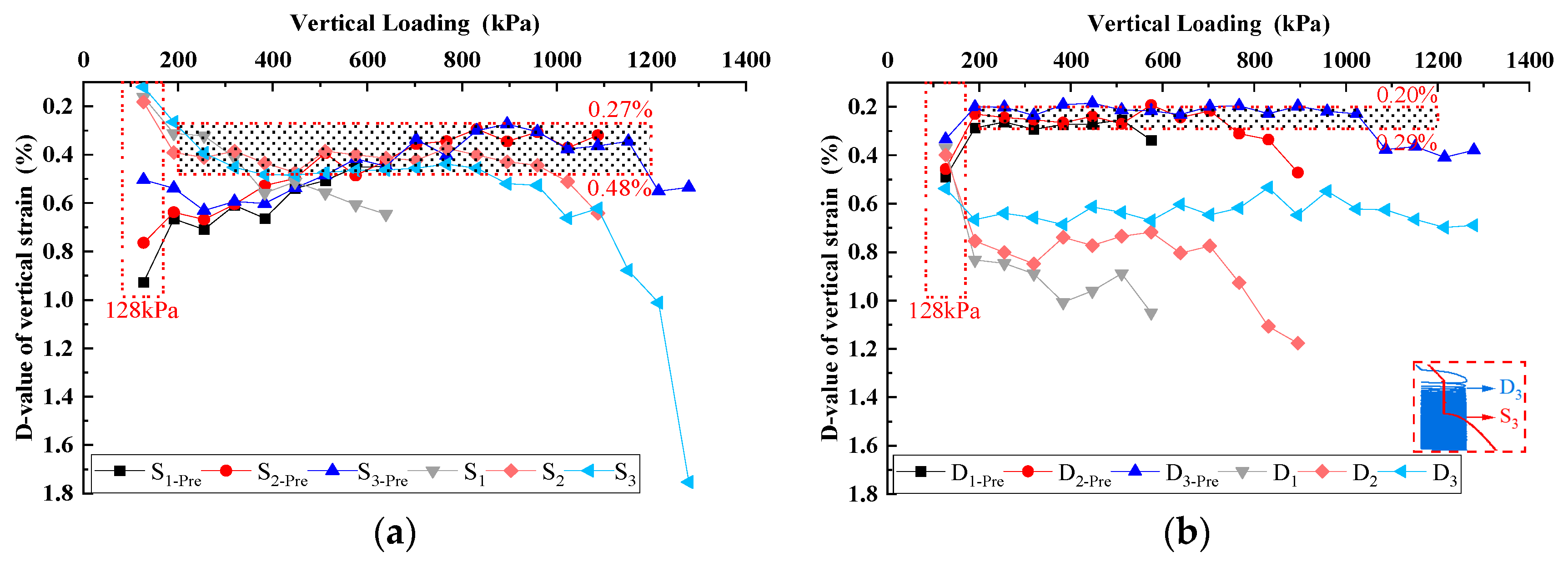
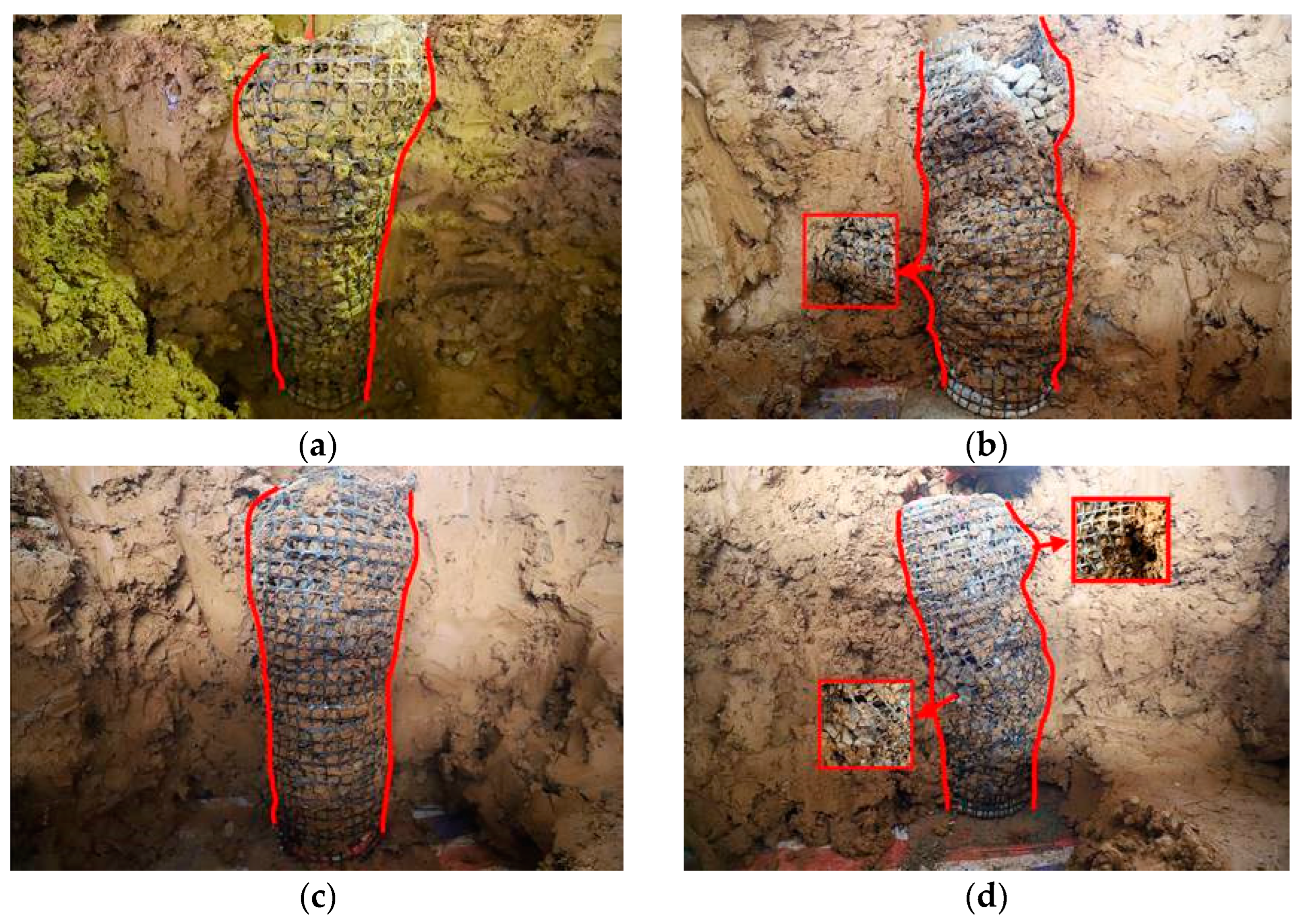


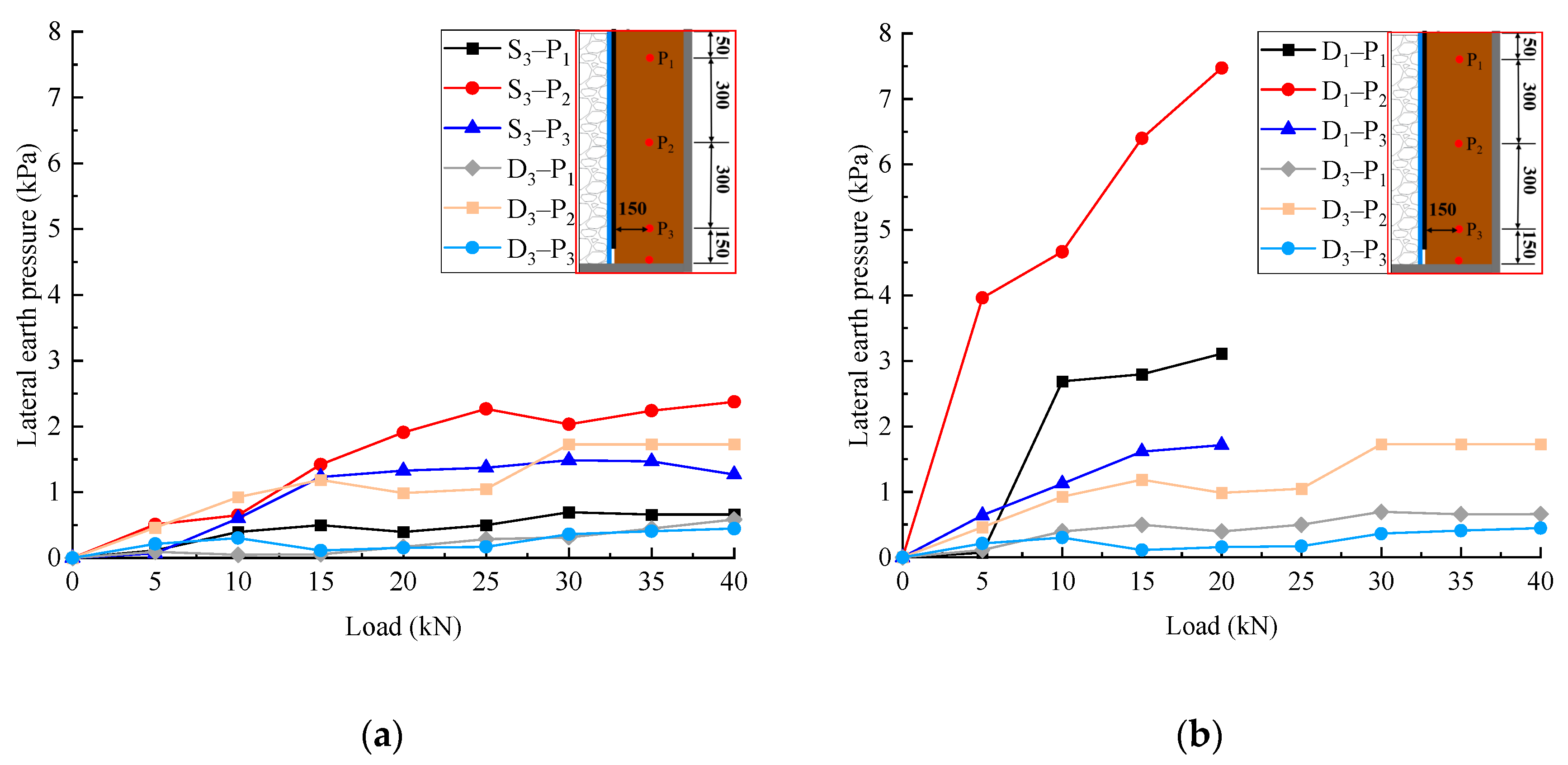
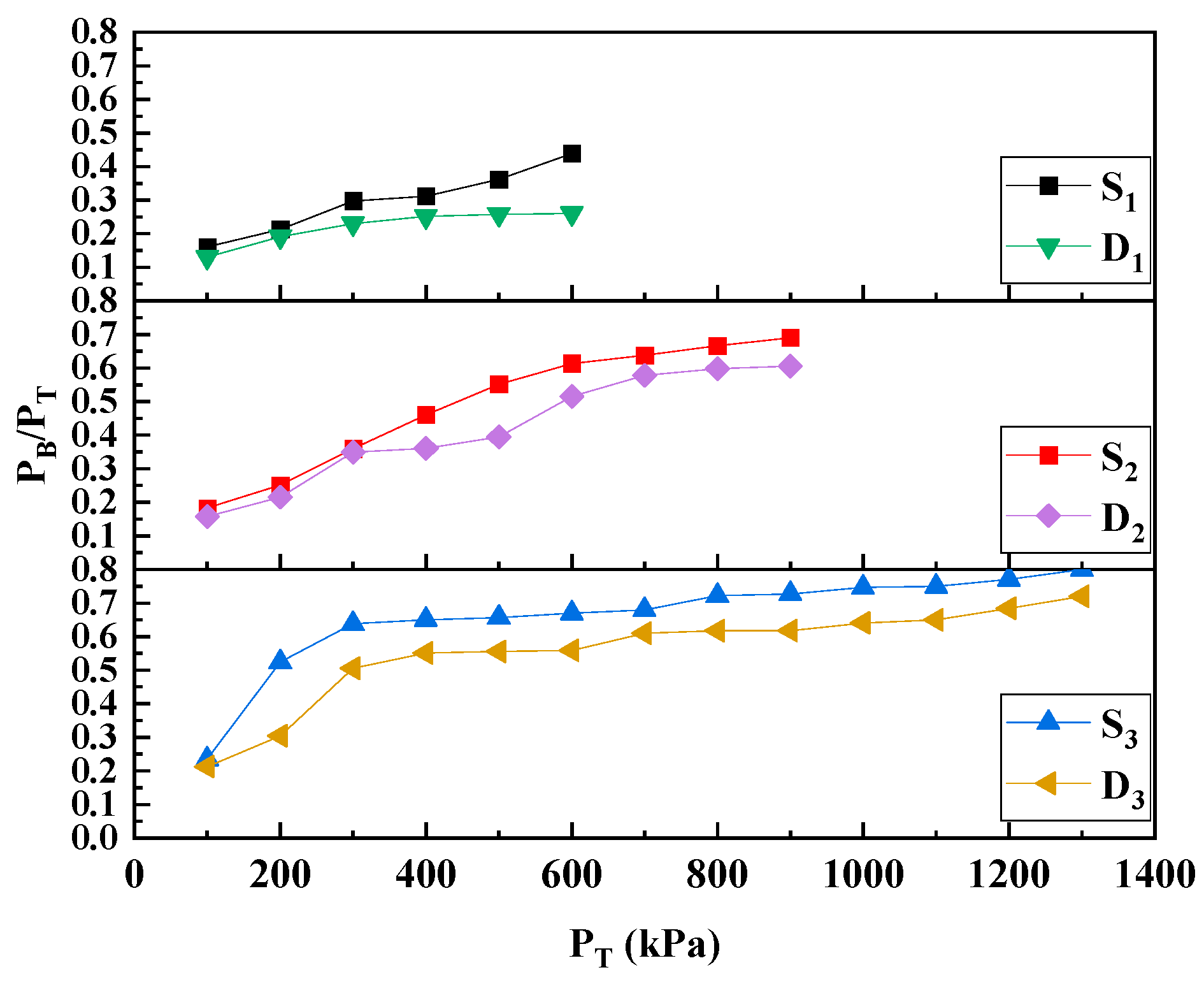

| Test No. | No. of Encased Layers | Column Length (mm) | Column Diameter (mm) | Particle Size (mm) | Loading Method |
|---|---|---|---|---|---|
| S1 | 1 | 800 | 200 | 20~50 | static loading |
| S2 | 2 | ||||
| S3 | 3 | ||||
| D1 | 1 | 800 | 200 | 20~50 | dynamic loading |
| D2 | 2 | ||||
| D3 | 3 |
| Parameters | Value |
|---|---|
| Liquid limit, wL(%) | 62.40 |
| Plastic limit, wp(%) | 32.20 |
| Plasticity index, Ip(%) | 30.20 |
| Specific gravity, (-) | 2.70 |
| Water content, w(%) | 54.20 |
| Item | Value |
|---|---|
| Longitudinal tensile yield force per meter (kN/m) | 18.6 |
| Longitudinal rib width (mm) | 3.0 |
| Longitudinal rib thickness (mm) | 1.5 |
| Transverse tensile yield force per meter (kN/m) | 15.4 |
| Transverse rib width (mm) | 2.0 |
| Transverse rib thickness (mm) | 1.0 |
| Node size (mm) | 4 × 3 |
| Mesh size (mm) | 20 × 20 |
| Test No. | Loading Frequency (Hz) | Maximum Radial Strain (%) | Ultimate Load (kPa) | Ultimate Vertical Strain (%) | Modulus (MPa) |
|---|---|---|---|---|---|
| S1 | 0 | 33.87 | 686.6 | 10.2 | 67 |
| S2 | 0 | 28.36 | 1140.0 | 15.2 | 75 |
| S3 | 0 | 19.40 | 1247.4 | 17.6 | 71 |
| D1 | 1 | 25.81 | 652.9 | 14.3 | 46 |
| D2 | 1 | 20.97 | 893.5 | 16.2 | 55 |
| D3 | 1 | 17.07 | 1421.9 | 19.9 | 71 |
Disclaimer/Publisher’s Note: The statements, opinions and data contained in all publications are solely those of the individual author(s) and contributor(s) and not of MDPI and/or the editor(s). MDPI and/or the editor(s) disclaim responsibility for any injury to people or property resulting from any ideas, methods, instructions or products referred to in the content. |
© 2023 by the authors. Licensee MDPI, Basel, Switzerland. This article is an open access article distributed under the terms and conditions of the Creative Commons Attribution (CC BY) license (https://creativecommons.org/licenses/by/4.0/).
Share and Cite
Kang, B.; Wang, J.; Zhou, Y.; Huang, S. Study on Bearing Capacity and Failure Mode of Multi-Layer-Encased Geosynthetic-Encased Stone Column under Dynamic and Static Loading. Sustainability 2023, 15, 5205. https://doi.org/10.3390/su15065205
Kang B, Wang J, Zhou Y, Huang S. Study on Bearing Capacity and Failure Mode of Multi-Layer-Encased Geosynthetic-Encased Stone Column under Dynamic and Static Loading. Sustainability. 2023; 15(6):5205. https://doi.org/10.3390/su15065205
Chicago/Turabian StyleKang, Bowen, Jiaquan Wang, Yuanwu Zhou, and Shibin Huang. 2023. "Study on Bearing Capacity and Failure Mode of Multi-Layer-Encased Geosynthetic-Encased Stone Column under Dynamic and Static Loading" Sustainability 15, no. 6: 5205. https://doi.org/10.3390/su15065205
APA StyleKang, B., Wang, J., Zhou, Y., & Huang, S. (2023). Study on Bearing Capacity and Failure Mode of Multi-Layer-Encased Geosynthetic-Encased Stone Column under Dynamic and Static Loading. Sustainability, 15(6), 5205. https://doi.org/10.3390/su15065205







